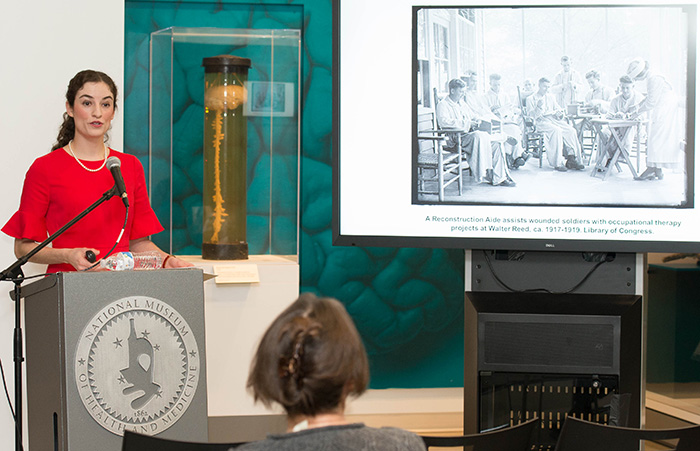Historian Shares Postwar Legacy of World War I Reconstruction Aides
By Lauren Bigge
NMHM Public Affairs Coordinator
The civilian American women who worked to rehabilitate wounded service members during and after World War I played a vital role in the commemorative culture of the postwar era, historian Allison S. Finkelstein explained to the Medical Museum Science Café audience at the National Museum of Health and Medicine (NMHM) on Nov. 14.
Finkelstein's research focused on female reconstruction aides, whom she called a "little remembered group of American women who served in that conflict." She developed her talk using sources she found during her ongoing research in the NMHM's Otis Historical Archives. "Female reconstruction aides viewed their wartime contributions as an essential form of military service during World War I, despite the fact that they actually served outside the official ranks of the military," she said. "They incorporated community service and veterans' advocacy into their commemorations of that war."
During the war, this group of women served in jobs that are known in contemporary America as physical and occupational therapists. Their duties often included teaching wounded service members to do craft-type projects, among other forms of therapy. The reconstructions aides helped the men to regain function in their hands and to keep their minds busy, which enabled them to "to regain confidence, and lead them down the path where they could gain employment after they were released from the hospital," Finkelstein said. In 1920, they organized the World War Reconstruction Aides Association (WWRAA). Many of the records from this organization can be found in the museum's archives and formed the basis of much of Finkelstein's presentation.
During the postwar years, the female reconstruction aides wanted to help both male and female veterans, so they focused some of their commemorative projects on community service and veterans' advocacy, an ideology that Finkelstein calls "veteranism." Her research demonstrates how many American women who contributed to the war effort considered community service and veterans advocacy to be more effective and sometimes more useful than other forms of commemoration, such as monuments or memorials.
"Women's leadership and service during the war helped secure passage of the 19th Amendment [of the U.S. Constitution, which granted women the right to vote] in 1920," Finkelstein said, noting that reconstruction aides were part of this groundbreaking group of women. They challenged the conventional thinking that military service could only be performed by the official members of the armed forces and they asserted their belief that their skills were essential to the nation's postwar recovery. "They tried to claim their place in the pantheon of military service, alongside male veterans," Finkelstein explained.
"The museum's Otis Historical Archives includes several collections of documents, photographs, archival records, and artifacts related to the reconstruction aides," said Laura Cutter, archivist. "These collections enabled Finkelstein to bring the history of the reconstruction aides to life with more specificity through the stories of their personal and professional lives that these women shared as they kept in touch with through the years."
Some collections include substantial materials related to several individual reconstruction aides, such as Lena Hitchcock and M. Estelle Angier. Hitchcock lived in the Washington, D.C. metropolitan area from 1907 to 1984; she was an occupational therapist reconstruction aide during World War I at Walter Reed General Hospital in 1918 before she went to France, where she was an occupational therapist and nurse's aide. She returned to Walter Reed in June 1919 where she continued in occupational therapy and was promoted to head aide. Angier served at Walter Reed General Hospital in 1918, caring for influenza patients. She was later transferred to Fort Sheridan, Illinois in April 1919 and became head aide, in charge of a clinical investigation of the recovery from peripheral nerve wounds. She served as a reconstruction aide until 1920.
The program included Alan Hawk, Historical Collections manager, who displayed objects related to the presentation: a blue uniform worn by Angier in 1918 and 1919; a physical therapist's uniform from the 1950-1970 era; panels carved as occupational therapy projects during World War I; and a toy truck assembled by a Walter Reed Army Medical Center patient in the early 2000s as he was working on his fine motor skills during rehabilitation.
Cutter presented reconstruction aides' records and insignia from the Otis Historical Archives. "I love hearing about how researchers interpret the NMHM collections and incorporate the archives' material into their projects," Cutter said. "As an archivist, I am able to see some of our collections accessed many times, by very different people, and each person finds something unique there. This is even truer at NMHM, where researchers may be historians or scientists, or both, or something else. Working with NMHM researchers is rarely routine - they never cease to surprise and have an endless capacity for curiosity."
"This year, several of the museum's Science Cafés commemorated the centennial of World War I," said Andrea Schierkolk, NMHM's public programs manager. "Finkelstein's presentation reinforced the commitment of reconstruction aides to their profession, during and after the war, and the role they played in preserving their own legacy."
NMHM's Medical Museum Science Cafes are a regular series of informal talks that connect the mission of the Department of Defense museum with the public. The NMHM was founded as the Army Medical Museum in 1862 and is an element of the Defense Health Agency-Research and Development Directorate. For more information on upcoming events, please call 301-319-3303 or visit www.medicalmuseum.mil.
Click any photo to view larger version





